Dressing up in extravagant pieces has always been the sartorial way of the subcontinent. And it’s no surprise that we have the Mughals to thank for that. Today marks the birth of one of the most successful Mughal Emperors, Akbar I, also popularly known as Akbar the Great, some 476 years ago. Born in present-day Sindh, Akbar managed to triple the empire in size and wealth during his reign. For the women of this time, a thriving empire meant indulging in opulent jewels and the finest fabrics. And while they don’t exactly make them like that anymore, we’re showing you eight garments commonly worn in Pakistan that were passed down to us by the Mughals.
Gharara
A popular choice for brides across Pakistan today, the gharara originated in the Awadh region of Uttar Pradesh. Mughal women mastered the art of wearing a gharara as it was commonly worn in their everyday lives. They wore the garment with short or long kurtas. Ghararas are defined by garments that gather with a joint at the knee, which is then embellished with a silver gota lace and then flared out from there.
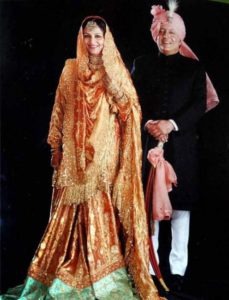
Farshi Pajama
Royalty and ladies from privileged classes of Uttar Pradesh wore the farshi pajama in the Muslim courts of Awadh. Modelled after the flowing gowns worn by British noblewomen, the farshi pajama is a flowing two-legged skirt held by drawstrings. It falls straight to the ankles, flowing onto the floor (or farsh). Wearing a farshi requires effort and balance. An expert wearer carefully holds the dress by pulling up and folding the excess trail in her left hand, keeping the right one free. The large quantity (historically 9-15 yards) of expensive cloth and embroidery used to make a farshi pajama reflected the grandeur and extravagance of the nobles and rulers of that era. Today, the garment is another popular choice worn by brides on their wedding.
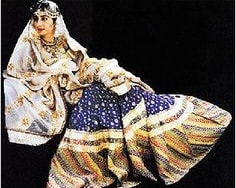
Angharka
A side-fastening cloak, tied at the waist with a flared ankle-length skirt – ring any bells? Angarkhas have been slightly modified over the years but still make an appearance at weddings, red carpets and of course all the fashionable runways in Pakistan. Interestingly, it was not the ladies of the Mughal Empire who wore this statement piece but the famous emperor Akbar, himself, debuted the angharka making it common amongst the men of the Mughal Empire.
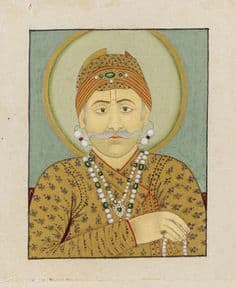
Anarkali (Peshwas)
The first empress to truly rule the Mughal empire, Nur Jehan, was known for her simple and modest pieces – the anarkali being one of them. A style named after her, an anarkali is a long, flowy kurta fitted till the waist and flowing like an umbrella with long pleats towards the legs. This garment has been modified over time, turning into both a peshwas and anarkali owing to their similar styles but will always allure the regal of Nur Jehan.
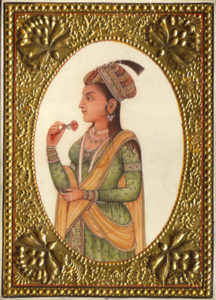
Front Open Jacket
Trust Mumtaz Mahal to give this world some style inspiration – be it the Taj Mahal, a monument of love or her very own fashion statement, front-open style jackets. The Queen was known not only for her beauty but also her impeccable fashion sense. She was always seen wearing a jacket (short or long sleeved) over her garments, giving birth to the idea of multi-layering and the front-open style jacket.
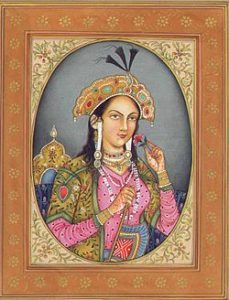
Izar
These are wide-loose pants – plain, dyed or striped. Commonly known as izar at the time of the Mughal Empire, izars were worn by both Mughal men and women and were usually paired with a peshwas or a kurta. Today, we call them culottes or wide-legged pants and these garments are now solely reserved for women. Usually worn with kurtas on top, izars are a popular choice for everyday attire. However, designers around the country have now popularised them as formal wear as well.
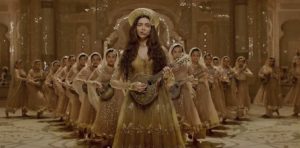
Churidars
Churidars are tightly fitting trousers worn by both men and women in the Mughal era. The excess length falls into folds and appears like a set of bangles resting on the ankle and hence the name churidar (meaning bangle like). In Mughal times, they were usually paired with a peshwas or a kurta. Today, the garment remains a favourite amongst Pakistanis, having made a comeback in a big way several years ago, it is still featured in collections by various designers and brands.
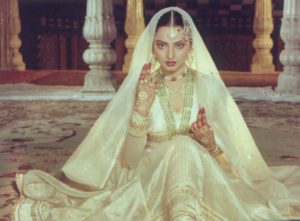
Shalwar
Part of the national dress of Pakistan, and commonly worn throughout the Indian subcontinent, the shalwar is a garment every Pakistani is familiar with. But a lesser-known fact is that we actually inherited the garment from the Mughals. The shalwar was actually a commonly worn garment worn by women in the Mughal court.
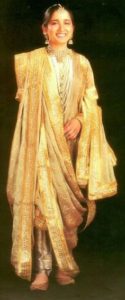









What do you think?
You must be logged in to post a comment.